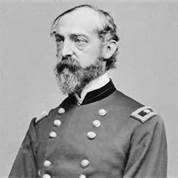Meade Replaces Hooker
In June 1863, General George G. Meade replaced General Joseph Hooker as commander of the Federal Army of the Potomac.
At the time, General Robert E. Lee’s Confederate Army of Northern Virginia was in the process of invading the North. Unsure of Confederate whereabouts, Hooker took eight days to leave Virginia in pursuit. The slow pace concerned Lincoln administration officials that Hooker may not be able to stop the Confederate invasion.
Hooker was infuriated when he was ordered by General-in-Chief Henry W. Halleck to hold Harpers Ferry and Maryland Heights. Hooker believed that this compromised his control of the army, and he tendered his resignation in protest. To his surprise, President Abraham Lincoln accepted. Hooker was unaware that Lincoln had been waiting for a reason to relieve him of command ever since his May defeat at Chancellorsville.

General George G. Meade
At 3 a.m. on June 28, Meade, commanding Fifth Corps, was awakened and ordered to take command of the army. Meade had no choice but to accept the tremendous responsibility and quickly formulate a strategy to stop Lee’s invasion.
By that afternoon, Meade developed a plan: “I must move toward the Susquehanna (River), keeping Washington and Baltimore well covered, and if the enemy is checked in his attempt to cross the Susquehanna, or if he turns toward Baltimore, give him battle.” Lincoln accepted Meade’s strategy and rejected panicked pleas to reinstate George B. McClellan to army command during this crucial time.Meanwhile, Robert E. Lee’s Confederates had captured Chambersburg and York. However, when Lee learned that Meade had replaced Hooker, he abandoned plans to attack Harrisburg. Instead, Lee turned back south and began concentrating his forces near Gettysburg and Cashtown. By June 30, the Federal vanguard was converging on Gettysburg from the south.





